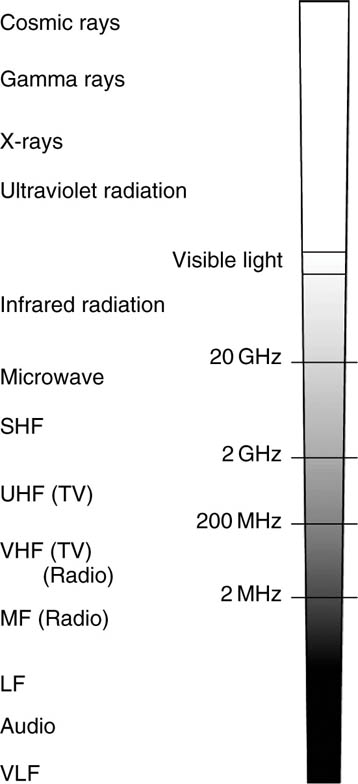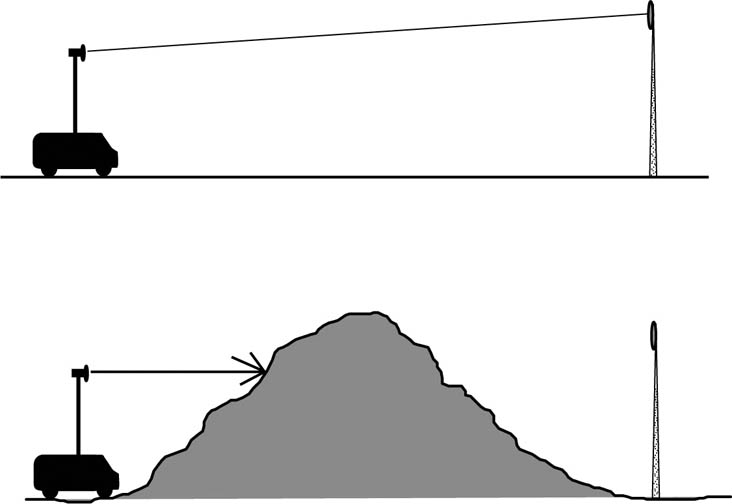Terrestrial microwave links
A microwave link fundamentally consists of a transmitter (often abbreviated to TX) and a receiver (RX). The transmitter and the receiver are each connected to an antenna. This is typically a parabolic dish antenna connected to the transmitter, and also typically a dish antenna at the receiver (though there are a few other specialized antenna types used with both the transmitter and the receiver).
The receiver needs to be typically within 65 km range of the transmitter – but this distance is very much dependent upon local obstructions and the geography of the land (the topography) on the path between the transmitter and the receiver. There are few hard and fast rules about what will and will not work, though the principal one is that if there is a large object in the path close to the transmitter, the link is unlikely to work.
Line of sight
In general, in order for microwave antennas to achieve clear transmission there must be an uninterrupted path between the transmitting antenna and the receiving antenna – termed ‘line of sight’. The maximum operating distance across each country between a microwave transmitter and a receiver is dictated principally by the curvature of the earth. Although as we have just noted, generally for a microwave link to work there needs to be a clear line of sight between the transmitter and the receiver. There are some circumstances where this need not be the case, as we shall see later.
Because the earth’s surface is curved, the effective distance between two points that can be seen is limited. If you stand at the seashore, in theory, on a clear day you can see to a distance of about 5 km to the level of the water at the horizon. If you were looking at say a ship on the horizon, you would be able to see it further – perhaps 15 km depending on the size of the ship – because of its height above the sea.
As we said earlier, ENG microwave trucks typically have a ‘pump-up’ mast that extends from 10 to 17 m, and this gives us a significant height advantage. If the receiver to which it is transmitting is perhaps 100 m high, then we can achieve a theoretical unobstructed distance of around 50 km.
Microwave frequencies
Microwave transmissions occupy the 2–50 GHz range of the electromagnetic spectrum. The higher the transmission frequency, for a given transmission power, the shorter the distance across which a reliable transmission can be achieved.
A microwave signal is characterized by the fact that it is at a very high frequency, and hence the wavelength (i.e. the distance between the peaks of the signal) is very small. In the frequency spectrum, microwaves sit some way above normal TV signals transmitted to the home, and below infrared radiation.
Electromagnetic spectrum

Microwave frequency bands for ENG
Microwaves have properties similar to visible light. They travel in a straight line; they cannot pass through solid objects; but they can be reflected off flat or curved surfaces like light from a mirror. The range of microwave frequencies used for terrestrial ENG are typically in the 2–8 GHz band, though this band is not exclusively for ENG use, but is shared with other microwave services.
This frequency band is used because it has been allocated by the global body that decides on RF usage, the International Telecommunications Union (ITU).
In the United Kingdom, the 2 GHz ENG band is divided up into 12 channels, each 20 MHz wide, spanning 2.44–2.68 GHz. The 7 GHz band has 4 channels. Across Europe there are similar allocations.
In the United States, the 2 GHz broadcast auxiliary service (BAS) band consists of 7 primary channels in 120 MHz, with channel 1 being 18 MHz wide while channels 2 through 7 are 17 MHz wide. The 7 GHz BAS has 14 channels, each 25 MHz wide.
There is therefore considerable pressure to share access to this relatively small number of channels in an equitable fashion.
TX and RX – line of sight and obstructed

Microwave – and the microwave
At this point let us just mention the ‘microwave’ that you are undoubtedly more familiar with (and with which you may have been a little confused about in our discussion here) – the microwave oven found in every kitchen. A microwave oven works by generating an alternating power field that agitates water molecules, resulting in the generation of heat. Remembering that most organic matter (plants, meat – that includes people) are mostly made up of water molecules, the food is heated from the inside outwards, leaving the dishes and the oven itself cool, because they are not directly heated due to their different molecular structure compared to living matter.
By international standard, the frequency at which microwave ovens operate is 2.45 GHz, and hence it is in the frequency band we are discussing. Might this cause interference problems? No, because the electric field generated inside the oven is very much focussed on the centre of the oven, and at a relatively low power.
So could microwave-transmitting equipment cause safety problems in terms of heating people up – the answer is yes!
Later on we will look at these safety issues, as it is perfectly possible for microwave-transmitting equipment to cause internal body heating when it is used incorrectly or if there is a fault.
